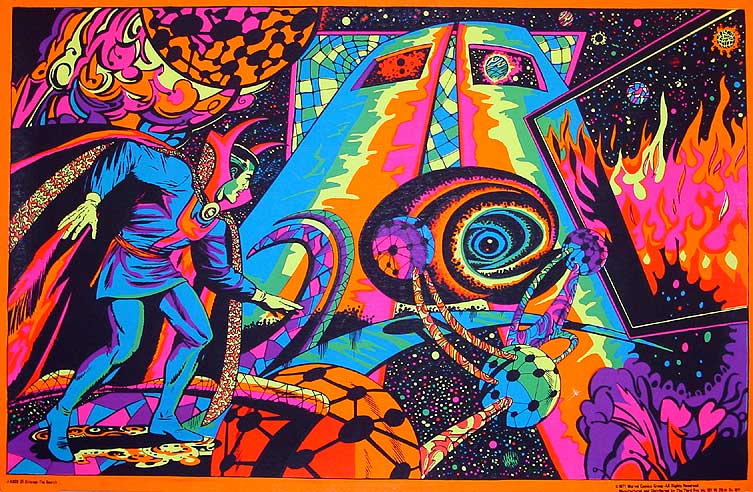From 1979 to 1981, I worked 10 hour swing-shifts at LaSalle's Adventure at Six Flags Over Texas. Riverboats, which have now been outfitted as swamp boats in East Texas, traveled on tracks in a large circle, beginning and ending at the dock. As I wrote in "Riverboat Ritualization," a piece published in the Moorish Science Monitor in the '90s, the continuous rounds left a heavy imprint in my brain, and the entire theme park experience gave me added insight into gnosticism and the simulacrum in the fiction of Philip K. Dick.
Ostensibly a narrative about the French exploration of Texas by LaSalle, the riverboat spiel that follows was constantly being tweaked and rewritten by those using it, to make it funnier or to simply avoid boredom of repitition. This version from 1978, the one I was handed as a yellow-tag trainee, is reprinted here for fun. The ride was closed in 1982 because it wasn't a "people mover." I had the honor of delivering the very last spiel, "the nasty version," to a crew of associates and friends.
For those interested in actual history, the journals of
Henri Joutel are in print and make fascinating reading about LaSalle's last voyage (he was shot in a mutiny somewhere in North Texas near the Trinity River).
In the meantime, enjoy the ride!

Good Day my friends, this is your captain speaking and I’d
like to welcome you all aboard my French Riverboat. Before we leave
the dock may I ask you all to please keep your hands and arms inside
the boat, since you never know when you might need them to swim back
to shore should the boat sink, or the captain abandon ship. The
brave at heart aboard this ship are volunteers for a very dangerous
mission as we’ll be traveling along waters much like the rivers the
French Explorer LaSalle travelled on in his search for the mouth of
the Mississippi. In addition to the Spanish, who had laid claim to
Texas when LaSalle first left a colony at Matagorda Bay, we will also
encounter both friendly and no doubt many unfriendly indian tribes
along our journey. And here is early proof of that, it would seem
that the indians have already attacked this French encampment and
that trapper has met with the same unfortunate end that many settlers
met within this wild new land.

Perhaps the most formidable four legged enemies that early settlers
faced in Texas were the gray wolves. Settlements or camps attacked by
the indians are soon taken over by the wolves, who often scatter the
bones up to a mile. Although not always as dangerous as Indians, the
Spanish had already laid claim that the territory of Texas when LaSalle
established his first colony, but the discovery of a French camp in
Spanish territory did cause the Spanish to step up their mission
programs. Mission San Francisco De Los Tajas was built in 1690 by
Father Massonet with the help of friendly indians from the area.
Many such missions are protected by Spanish Forts such as the one
up ahead. Since they fly the Spanish Flag and we’re French, we must
try to slip by unnoticed. Luckily there’s no one in the watch
tower so if you’ll all be very quiet we’ll try to make it by
....But oh no! That Spanish soldier has spotted us...they’ve
opened fire! Full speed ahead. Careful, a near miss on the port
side, another near miss, prepare to abandon ship! Women and children
first, after the captain of course. But wait! They’ve ceased fire,
it would seem as though the spanish can’t hit the broad side of a
little French Riverboat.
Over to my right you’ll see something that’s becoming very common
along the Rivers in Texas. Trading Posts appear to be an excellent
way to make friends with the indians.
Trading posts have also inspired many trappers to come to Texas.
A trapper friend of mine, Francious knows this area well, and he’s
usually around here so keep an eye out for him. There he is now in
the top of that tree...I’ll ask him in French if its safe to go on...
(away from mike) "Francious my friend, is it safe to go on?" Unfortun-
ately he’s shaking his head no, which in French means no - but, the
rivers too narrow to turn around right here, and besides, I’m not
ready to risk another pass by those Spanish cannons. So we’ll continue
on for the glory of France. I believe Francious has a small camp
along here, and perhaps we’ll be able to stop for some good food and
company.
But no, there will be no stopping here, the camp is under attack
by indians and I’m afraid we’re caught in the crossfire! Everybody
quick, down in the boat - we’ll duck now and ask questions later.
Those bullets are real my friends, have no doubt, real enough
to ruin even those barrels of good French Wine. They really know
how to hit a frenchman where it hurts, don't they? In the wine
barrels!
Mon Amis we are now entering the most dangerous part of our
journey, swamp lands, infested with huge hungry alligators. Let me
once again remind you to keep your hands and arms inside the boat
because these gaters just love to be hand fed, and once in the water,
there's not a man alive that can out swim one of these monsters.
What!?! No need for alarm, its just a bear fishing for some dinner in
the river, we probably disturbed him. Quick Look! There's something
moving in the bushes (pointing to port side) I'm sure I saw something
move up there....Look Out! Its an indian war canoe, everybody duck
down! Those arrows are tipped with poison, one scratch could mean
instant death. Luckily they didn't shoot!
On my right you'll see what they were probably trying to protect
an indian burial ground. As you can see indian customs require that
they bury their dead 6 feet above the ground. Burial grounds are
sacred, and trespassers are dealt with severely. Some tribes even
sacrifice a dog, horse, or even a woman with a dead warrior.
With a burial ground here a village can't be far, so we will
try to proceed quietly and carefully along.
And just as I thought, here is the Indian village. That medicine
man is really a priest for the tribe, and there's no tellings what
that dance he's doing is supposed to do; I just hope it's not going
to do it to us!
Luckily, I don't see any warriors around, just young braves
and squaws tanning hides and preparing some of their favorite
dishes, perhaps boiled earth worms and raw fish.
Quiet everyone, over on the shore is a black bear. I hear that
many settlers along the river call the black bear the clown of the
woods, but considering his tone of voice right now, I'd say those
sounds were more like hunger pains than jokes.
Traveling along the river can be very dangerous, but traveling
the shore is next to impossible because of the thick brush and the
many wild animals along the shore.
Here you can see a single bear fighting for his life against
some very dangerous enemies. The wolves are very careful though
because that bear's teeth are very sharp, not to mention the
power in his "bear" hands.
Quick everyone, lean to the port side of the boat; for over
on the starboard is a whirlpool. That poor soul is already on his
way to a watery grave, but you've got to give him credit, he did
save that piece of drowning wood.
To the left a pack of beavers, an important source of income to
many trappers and a source of trouble to many captains as they often
pose a menace to navigation. Look Out! Timber... Well, it that
tree had been a little longer this boat and this trip would have
been alot shorter.
I hope you are all brave for ahead lies unchartered waters and
there is no way of telling just what might be waiting for us.
Look... Indians! On both sides of the shore, everyone bravely
River and quickly duck! I'd say those Indians have only one goal, to get
a head. So it's full speed ahead for us. But wait! A waterfall
with a solid rock wall behind it. I'm afraid our journey has come
to an end if you'll all prepare to abandon ship on the count of
three, One... Two... WAIT! The waterfall has parted, the rock wall
is opening. I believe we've stumbled on an ancient Indian treasure
cave. Many explorers gave their lives in search of caves such as
this containing Indian gold and treasure.
Perhaps we should reconsider and turn back, but I'm afraid
we can't! The doors have closed and we're trapped inside. Look,
to the right, treasure! But don't take any, it's being guarded by
that skeleton. Oh no! more trouble, a rock wall ahead... but no,
I see light, the wall is swinging open. The Indians have rewarded
us with our lives for not stealing their treasure.
And there is the flag of France flying proudly above Ft. St.
Louis. Viva la France, we've made it back to safety!
I want to thank you all for being such a brave crew and accom-
panying your not-so-brave captain on this very dangerous journey. I
hope you enjoy the rest of your stay at Six Flags Over Texas and come
back and see us again real soon.
Now as we approach the dock, please keep your hands and arms inside
the boat, wait till we come to a complete safe stop, then exit on the
dock side only. You'll find it a little drier there.
On the dock we should find a beautiful glamorous French sailor
girl (or handsome, de bonair, exciting French sailor) to help you out
of the boat. But as you can see she (or he) didn't show up ... so
(name of host or hostess) will have to do.
River
Now mates and matees, the time has come to say mersi beau
coup and au re voir: which is Texas French for thank you very
much... and abandon ship before she sinks.














